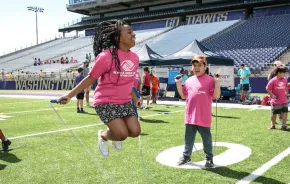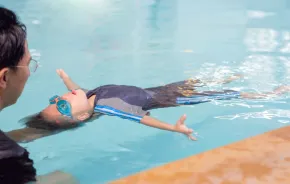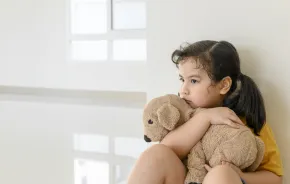
By Caroline Chen, ProPublica
Editor's note: This story was originally published by ProPublica.
Children as young as first graders may be able to get the coronavirus vaccine by the time school starts in September, presuming trials are successful in those age groups, Dr. Anthony Fauci, director of the National Institute of Allergy and Infectious Diseases, said in an interview with ProPublica.
“We’re in the process of starting clinical trials in what we call age de-escalation, where you do a clinical trial with people 16 to 12, then 12 to 9, then 9 to 6,” Fauci said. When asked what was the youngest age group that might be authorized for the vaccine by September, he said, “I would think by the time we get to school opening, we likely will be able to get people who come into the first grade.”
As optimistic as Fauci is, several pediatricians and infectious disease experts said they wish the pediatric trials would move more quickly. In addition to restoring stability to the education system and parents’ work schedules and keeping kids and those around them safe, vaccinating children is essential to helping the country, as a whole, reach herd immunity and decrease the threat of new variants.
Otherwise, “we’re going to have tens of millions of individuals in our communities that are able to maintain the virus. And when that happens, what that allows is for these unusual variants to emerge that may have the ability to evade our immunity,” said Dr. Buddy Creech, associate professor of pediatrics and director of the Vanderbilt Vaccine Research Program.
Despite the need, Pfizer is the only manufacturer whose pediatric vaccine trials are far enough along to potentially have data on elementary-school age children by the end of the summer.
Pfizer has finished enrolling participants in its study of 12- to 15-year-olds and anticipates having data in “the early part of 2021,” according to a spokeswoman. “From there, we will plan to finalize our study in 5-11 year olds,” she added. As Pfizer completes its trials in adolescents, then 5- to 11-year-olds, it’ll need to submit the data to the U.S. Food and Drug Administration for review and get authorization for the vaccine’s use in those age groups before it’s available; currently in the U.S., the vaccine is indicated only for those ages 16 and up.
Moderna is still enrolling participants in its trial for adolescents ages 12 to 18, and it is “on track to provide updated data around mid-year 2021,” the company said in an emailed statement. Stéphane Bancel, Moderna’s chief executive officer, has said that the company’s goal is to have data from the adolescent study in advance of the 2021 school year. Moderna said it’ll begin an age de-escalation study in children ages 11 years to 6 months this year, but Bancel has said that the company doesn’t expect clinical data until 2022.
Johnson and Johnson hasn’t started any pediatric studies yet. “We are in discussions with regulators and partners regarding the inclusion of pediatric populations in our development plan,” a spokesman said. Novavax, similarly, hasn’t begun any trials in children, and a company spokeswoman said it couldn’t share any details at this time. The University of Oxford, which partnered with AstraZeneca in developing a vaccine, will begin tests in 12- to 18-year-olds next month, according to Bloomberg News.
The American Academy of Pediatrics has been “really advocating to try and make these trials happen with the same urgency that they happen for adults,” said Dr. Sean O’Leary, who is vice chair of its committee on infectious diseases.
The manufacturers will need to prove vaccines are safe and effective in younger bodies. The adult trials paved much of the way, but researchers still need to study how kids’ immune systems react and to confirm the optimal dosage. And even if the shots are authorized by September, there will need to be enough supply on hand in order to get school children immunized before school doors open.
It’s essential to act expeditiously, O’Leary said. “I would love to see a vaccine available for all children in time for the next school year.”
Why It’s Important to Vaccinate Kids Against COVID-19
Early on in the pandemic, some thought that children might be entirely immune. That’s clearly been disproven. Out of more than 20 million U.S. cases where age information is available, about 2.2 million, or 11%, have been in children under 18. Some get very ill, though this is rare. As of Feb. 8, the Centers for Disease Control and Prevention has tracked more than 2,000 cases of what’s known as multisystem inflammatory syndrome in children (MIS-C), a serious condition associated with COVID-19 that can result in cardiac dysfunction and kidney injury; 37% of the cases recorded were in Latino children and 32% in Black children.
It’s also become evident that children are capable of transmitting the virus to some extent. On one hand, kids aren’t superspreaders: COVID-19 is clearly dissimilar to influenza or the common cold virus, Vanderbilt’s Creech pointed out. “You put one of those in a classroom, then in a few days, it’s overrun,” he said. “That’s not what we see with COVID.” But exactly how infectious children are remains somewhat unclear, in part because schools have not been fully open, making it hard to gather data, said Dr. Yvonne Maldonado, a pediatrician and professor of global health and infectious diseases at Stanford University. Studies from other countries, while informative, may not always extrapolate well to the U.S., she added.
So while the “preponderance of data” points to children being less likely to infect people when compared with adults, “they certainly do,” said O’Leary, who is also a professor of pediatrics at the University of Colorado School of Medicine. “So, if you’ve got vulnerable people in the household and your 7-year-old comes home with COVID, it’s not to say they can’t give it to anybody else. They absolutely can. It’s just a bit less likely.”
It’s important to note that the vaccines have only been proven — so far — to prevent disease and not infection (data on that is harder to gather and takes longer to prove), which means it’s not guaranteed yet that vaccinated individuals can’t spread the coronavirus.
But there are some inklings of hope that vaccination can at least reduce onward transmission. So if this bears out, the more people who are vaccinated in a community, including children, the more likely transmission will drop overall.
“Our current chaos about children not being in schools is just terrible for children, and I think a lot of the concern would be assuaged if children were immunized,” said Dr. Sarah Long, professor of pediatrics at the Drexel University College of Medicine. “That doesn’t mean to me that they can’t get the infection or transmit it every once in a while, but it would reduce those possibilities tremendously.”
Long is also a member of the CDC’s Advisory Committee on Immunization Practices, where she has been reviewing the trial data and helping to make recommendations on how the vaccines should be used. She continued: “There are real virus control reasons, there are real societal reasons and there are economic reasons, because if children can’t go to school, people can’t work.”
O’Leary said children as young as 6 months, which is the youngest age that Moderna plans to test, can get vaccinated so long as trial data shows the vaccines to be safe and effective. Infants under 6 months are likely to be protected by antibodies transferred through the placenta if the pregnant mother is vaccinated, he added.
How the Vaccine Will Be Studied in Kids
The pediatric vaccine trials will not be as large as the final stage adult trials, which enrolled 30,000 or more participants, giving a placebo to half and the vaccine to half. Pfizer’s 12- to 15-year-old study has enrolled 2,259 participants and Moderna’s adolescent trial is a similar size, aiming for about 3,000 participants. In both trials, some teens will receive a placebo.
That’s enough to prove safety and benefit, experts said, in part, because the adult trials have already paved the way. To show the vaccine is safe, among the many things that Pfizer is tracking includes the percentage of participants reporting “local” reactions such as pain at the injection site, redness and swelling, as well as the percentage of participants reporting systemic reactions such as fever, headache, chills, vomiting, diarrhea, muscle pain and joint pain.
After the trials are completed, tracking for any safety issues will continue in the real world as physicians and patients will be encouraged to report to the FDA and CDC any side effects they think may be due to the vaccine.
Doctors said they’d want to make sure that there are no signs that the vaccine overinflames the immune system or causes any allergic or autoimmune responses. “I think most people that are developing these vaccines feel like the vaccine is not going to trigger MIS-C, but it’s something that will be monitored for very closely both in the trials and more importantly, post-licensure,” added O’Leary, from the University of Colorado. Maldonado said she’ll also be on the lookout for any cases of Guillain-Barré syndrome, which is often a concern when it comes to vaccines, but she noted that no significant increases in cases were seen in any of the adult trials.
When it comes to proving benefit, the pediatric trials will focus on a different metric than the adult trials. The adult trials’ primary efficacy measure was to compare how many vaccinated people wound up sick with COVID-19 symptoms compared with those who received the placebo and whether the vaccine impacted the severity of illness. Since children rarely are hospitalized due to COVID-19, the vaccine’s ability to reduce severe cases would be hard to measure unless the trials enrolled an enormous number of children.
Instead, Pfizer’s and Moderna’s adolescent trials will focus on evaluating participants’ immune response by measuring antibodies, according to Pfizer’s spokeswoman and Moderna’s clinical trial website.
Scientists haven’t yet identified an “immune correlate of protection,” which is usually defined to be the level of antibodies in the blood at which they can feel confident that a person is going to be protected from infection. Some vaccines that have been approved, like the one for measles, have an immune correlate of protection identified, while others don’t.
In the absence of a definitive immune correlate of protection, the trials would compare antibody levels in children with those found in adults and extrapolate that the efficacy should then be similar. The FDA and advisory groups like the CDC’s Advisory Committee on Immunization Practices would then need to discuss whether the evidence is compelling. If scientists are able to identify an immune correlate of protection, however, “and you can demonstrate that kids get that with the vaccine, that’s even more satisfying,” O’Leary said.
One final difference in pediatric studies is the potential for lower doses. Moderna has said that it will run its studies of children under 12 testing lower doses first.
“As we go down in age, we give the smallest possible dose of vaccine that we think is reasonable, and then we steadily increase until that point when we get that magic ‘Goldilocks’ level at which it works great and the side effects are tolerable,” Vanderbilt’s Creech explained. “I don’t think one dose fits all.”
A Call to Speed Pediatric Trials
Some pediatricians and infectious disease experts said they were eager for pediatric studies to move faster.
“My understanding is that the entity formerly known as Operation Warp Speed had a lot of involvement with those adult trials, but with pediatric clinical trials, they’re not having the same degree of involvement,” O’Leary said. “So it’s more up to the manufacturers, and from my perspective, these manufacturers don’t have the financial incentive to conduct these trials with the same urgency that they did with the adult trials.”
Stanford’s Maldonado added that she’s concerned that there’s not as much pressure on the manufacturers to recruit children of diverse backgrounds as there was for the adult trials.“I think it’s important to get those kids in to understand factors around the actual vaccine and also to get buy-in of those communities where we’re seeing more hesitancy. We want to make sure they are feeling comfortable about being represented,” she said.
While O’Leary is not as confident as Fauci that we’ll see Pfizer’s data on younger kids by September, he feels very optimistic about the availability of a vaccine in the coming months for kids as young as 12, who tend to get sicker than the younger age group.
“I think that’s a really big deal,” he said.
ProPublica is a Pulitzer Prize-winning investigative newsroom. Sign up for The Big Story newsletter to receive stories like this one in your inbox.











